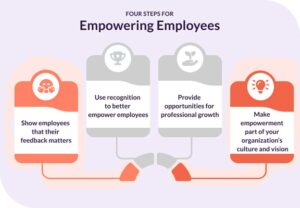Gritty Practical Leadership Book Five Star Review Try It on Amazon
Real Leadership Without the Gloss — Lessons That Last –Book Review Introduction Most leadership books fall into one of

Today’s highly competitive company environment makes it a strategic need rather than merely a managerial choice to fully use people’ potential. Employee transformation from passive components of the company’s machinery to active, productive contributors calls for a sophisticated strategy that combines inspiration and empowerment. This article uses both creative language and practical ideas to examine the key tactics for bringing about this change.

Productivity is based on empowerment, which is the skill of giving employees power and freedom. In order to achieve true empowerment, businesses need to abandon old hierarchical guidelines and adopt a more egalitarian strategy. This paradigm changes calls for the following key tactics:
A foundational element of employee empowerment is autonomous agency. The idea behind this is to provide workers the freedom to choose within their area of duty. Companies encourage a culture of accountability and ownership by giving people the flexibility to choose their own path. Making ensuring that this autonomy is combined with specific, goal-oriented objectives is crucial in this situation. Employee engagement and productivity naturally soar when they are aware of the organization’s overarching goal and are given the freedom to choose their own route to success.
Investing in ongoing professional development is another way to empower staff members. Opportunities for skill enhancement are highly valued by the modern worker. Companies who provide opportunities for professional development and continuous training not only help their staff become more competent, but they also demonstrate a dedication to their own personal development. Establishing comprehensive learning and development initiatives guarantees that staff members are not just doing job duties but are also developing in accordance with their goals and the goals of the organization.
Despite being viewed as an ethereal attribute, inspiration is essential for increasing worker productivity. In order to effectively inspire others, leaders need to foster an atmosphere that ignites passion and zeal. Here’s how to do it:
Inspiring leadership is anchored by vision. A sense of purpose that permeates the entire organization is created by leaders who can clearly communicate their vision. This vision ought to be more than just an aspirational declaration; it ought to tell a story that workers can identify with. People are more likely to be motivated and invested in their job when they see how their tasks fit into a bigger, more significant goal.
The harmonic alignment of personnel beliefs and organizational values is known as cultural synergy. An organization where employees actively create and maintain a unified culture creates a profound sense of belonging. This sense of belonging and common purpose boosts productivity and improves job satisfaction. Leaders must provide an example of the values they want to see in others and provide avenues for candid criticism in order to foster cultural synergy.
Empowerment and inspiration must be translated into workable tactics, which call for careful execution. The following actions can be taken to put these ideas into practice:
Delegating strategically and effectively is essential to employee empowerment. This entails delegating work as well as offering the tools and assistance required for completion. Striking a balance between allowing liberty and retaining monitoring should be the goal of managers. Frequent check-ins and feedback loops guarantee that staff members stay in line with company objectives while also having the flexibility to be creative and self-starters.
Acknowledgement is an effective source of motivation. Honoring accomplishments, no matter how little, fosters an excellence culture and inspires staff members to pursue greater success. Acknowledgement must be sincere and consistent with the organization’s principles. Putting in place an organized recognition program with formal awards and peer-to-peer evaluations can aid in the development of a positive feedback loop.
Strong feedback systems are necessary for inspiration and empowerment. A strong feedback system lets staff members express their opinions and gives them the knowledge they need to develop and get better. Consistent performance evaluations combined with helpful criticism assist staff members in identifying their areas of strength and growth. Asking staff members for their opinions on organizational matters also encourages engagement and dedication.
The ultimate objective of these tactics is to foster a synergistic impact where inspiration and empowerment come together to yield remarkable outcomes. Employees become more than just effective workers when they are given the freedom to make their own decisions and are motivated by a common goal and positive work environment.
In summary, transforming staff members into effective workers involves more than just putting a set of strategies into practice—it also entails fostering an atmosphere where motivation and empowerment are fostered. Organizations may unleash the potential of their workforce through the following strategies: allocating resources for skill development, creating a compelling vision, promoting autonomy, and cultivating cultural consensus. As a result, the company is led by a vibrant, committed team that achieves previously unheard-of levels of success and creativity.
Real Leadership Without the Gloss — Lessons That Last –Book Review Introduction Most leadership books fall into one of
A Masterclass in Leadership Through Real Stories Leadership Stories from the Corporate Jungle and Navy Deck Plates: Real Lessons,
Dr. Tom DePaoli CEO Apollo Solutions won an award for his book “Leadership by Storytelling: The Best Way to Learn Good Leadership Skills”,
Copyright © 2024 Dr. Tom’s Advice Blog | Powered by Dr. Tom’s Advice Blog